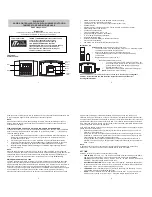
111
This document is intended for Public Distribution
19473 Fraser Way,
Pitt Meadows, B.C. Canada V3Y 2V4
Appendix B
B-1
TR-SL2 Series
Tranzeo Wireless Technologies
Tranzeo Wireless Technologies‘ software ensures a consistently high quality
online experience through the use of powerful Quality of Service (QoS)
mechanisms. The key to making this applicable in a WISP environment is the
Intelligent Stream Handling, a patent-pending algorithm that autonomously
manages the flow of traffic going to the Internet without the need for user
configuration. As a result, real-time, interactive traffic—such as gaming, VoIP,
and video teleconferencing—is automatically given the appropriate priority when
other users and applications use the connection. In addition, Intelligent Stream
Handling minimizes the impact of large packet, lower priority traffic on latency-
sensitive traffic and eliminates delays. Tranzeo software effectively eliminates the
lag and breakup problem in online gaming and other voice and video applications.
In today's broadband environment, the impact of just one data stream running in
parallel with a real-time application can be quite dramatic. Using NetIQ's Chariot
VoIP test measurement over a connection, it can be demonstrated that introducing
a single FTP transfer in the upstream direction will reduce the Mean Opinion
Score (MOS) for a G.729 VoIP codec from a very good 4.4 to a completely
unacceptable level of 1 immediately. Using the same scenario with Tranzeo‘s QoS
enabled, the voice quality remains consistently high with an MOS of 4.4, and
maintains that level even with multiple FTP streams.
Automatic Traffic Classification
Tranzeo software has the capability of continually monitoring and classifying
traffic on the Internet connection, and dynamically adjusting the way individual
streams are handled at any point in time. This enables latency-sensitive traffic—
such as voice, games, or even web page requests— to be given a relatively high
priority. As a result, these packets are sent to their destination first, reducing delay
and jitter. Less time-sensitive traffic—such as email or file transfers—are sent at
lower priority. Since Intelligent Stream Handling operates automatically without
the need for user configuration, it is able to effectively use 255 priority levels for
fine-grained control of the packet streams.
Rate Matching
A process called "rate matching" determines the bandwidth of the broadband
uplink automatically so that it can shape the traffic to smooth the flow between the
router and the Internet. This eliminates the potential bottlenecks and delays that
can be caused by "bursty" data traffic.
Dynamic and Adaptive Link Fragmentation
Low priority traffic is also fragmented to reduce the latency and jitter that can be
introduced by long packets. Intelligent Stream Handling adjusts the fragment size
based on the uplink speed and also stops fragmenting long packets when no
latency-sensitive traffic is waiting to be sent, to improve the overall efficiency of
the broadband link and ensure voice can sustain a high MOS rating.
Appendix B: Quality of Service
Configuration (QoS)
















































